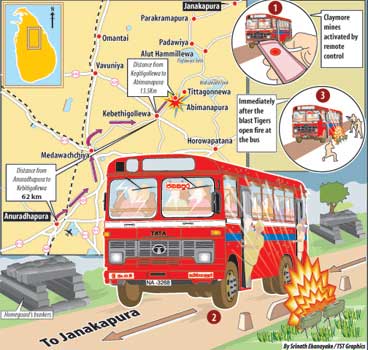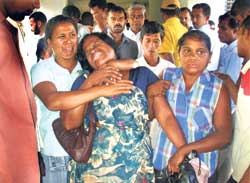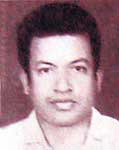
Kebethigollewa: Bombs on the battered track~ Tigers repeat their cowardly act; authorities beef up security
Abimanapura, Kebithigollewa: S. Podinona’s husband died in the Anuradhapura hospital in the morning. After attending to formalities in the hospital, she rushed to the main bus stand in the city centre to catch the last bus to Janakapura via Kebethigollewa. The time was 5.45 p.m. As she approached the bus stand, she could see the bus leaving. The poor woman acted fast. She got into a three-wheeler and overtook the bus. Satisfied she had managed to catch the bus, she reminisced about the days she had spent with her husband and planned the funeral arrangements as the bus moved along. Tea before terror At 7.25 p.m., the bus stopped at Kebethigollewa. Some 20 passengers got off the bus while others had a cup of tea from the wayside boutique. After the short tea break, the bus resumed the journey unaware of the danger that lay ahead. Thirty minutes later, two big blasts hit the bus, killing and wounding passengers. The wounded were screaming both in pain and in fear. Before they could realize that they had become the latest victims of heartless terror, there was gunfire. LTTE gunmen sprayed bullets at the bus, which had come to a halt, before they fled the scene. The final toll stood at 16 killed and 23 injured.
Podinona survived with injuries to relate the horror. “The bus was hit by two blasts. I heard sounds of gunfire following the explosions. I managed to get out of the bus, creep into a culvert and remain there. I heard people screaming and crying for help,” said Podinona who is receiving treatment at the Anuradhapura hospital. Premalal Sumanathillaka, another wounded passenger, said he knew it was a bomb attack and saw people crying in pain and some profusely bleeding. He said he managed to creep under a seat and stayed there till soldiers arrived at the scene. Among the dead were two soldiers who were returning to their camp at Welioya after their leave. Travelling with them was 18-year-old soldier Sugath Bandara who got into the bus at Kebethigollewa. He was seriously wounded in the leg and transferred to Colombo National Hosptal. This young soldier said he saw some ten to 15 LTTE cadres firing at the bus following the explosions. He said he dragged himself to the jungle and remained there till soldiers arrived at the scene. Homeguards not to be seen An angry Bandara asked why there was no immediate assistance from the homeguards who were at scores of bunkers that dotted the boundaries of Kebethigollewa. Among those who were killed was provincial journalist, W. Gunasinghe, 62 who had highlighted the security problems the Kebethigollewa village and its residents were facing after a deadly bus explosion in June last year. Some 64 passengers died in that blast after which hundreds of villagers fled Kebethigollewa and remained in schools and temples in safe areas as refugees for months. They returned to their vulnerably situated village south of rebel-infested Vavuniya, only after the government took several measures to ensure the security of the village. But despite these security measures, which included a series of bunkers manned by homeguards, most villagers lived in fear. Confirming their worst fears, the Tigers struck on Wednesday. Investigations have revealed that the guerrillas had infiltrated through a gap between two guard posts. Each of these guard posts was manned by three homeguards. The Tigers had planted the claymore mines facing the road. One hit the bus while the impact of the second mine was largely directed towards the ground where now remains a crater. New measures In the aftermath of the second bus attack in as many years in the same village, the authorities are to adopt fresh measures to beef up security of the village. Among these measures are:
|
|| Front
Page | News | Editorial | Columns | Sports | Plus | Financial
Times | International | Mirror | TV
Times | Funday
Times || |
| |
Reproduction of articles permitted when used without any alterations to contents and the source. |
© Copyright
2007 | Wijeya
Newspapers Ltd.Colombo. Sri Lanka. All Rights Reserved. |


